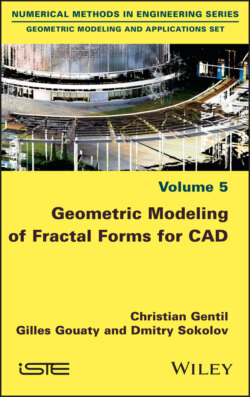Geometric Modeling of Fractal Forms for CAD

Реклама. ООО «ЛитРес», ИНН: 7719571260.
Оглавление
Christian Gentil. Geometric Modeling of Fractal Forms for CAD
Table of Contents
List of Illustrations
Guide
Pages
Geometric Modeling of Fractal Forms for CAD
Preface
Introduction. I.1. Fractals for industry: what for?
I.2. Fractals for industry: how?
1. The BC-IFS Model
1.1. Self-similarity and IFS
1.1.1. Mathematical definitions and reminders
1.1.1.1. Working space
1.1.1.2. Geometric transformations
1.1.2. Self-similarity
1.1.3. Examples. 1.1.3.1. The Cantor set
1.1.3.2. The Cartesian product of two Cantor sets
1.1.3.3. The Sierpinski triangle
1.1.3.4. The Menger sponge
1.1.3.5. The Romanesco broccoli
1.1.3.6. Non-fractal self-similar object
1.1.3.7. L-shape
1.1.4. Iterated function systems
1.1.5. Visualization and approximation
1.1.6. Computer implementation
1.1.7. Notions of address and parameterization
1.1.8. Finite address
1.1.9. IFS morphisms
1.1.10. Example of a curve
1.1.11. The example of the Sierpinski triangle
1.2. Controlled Iterated Function System
1.2.1. Formalization
1.2.2. Visualization and approximation
1.2.3. Implementation
1.3. Boundary controlled iterated function system
1.3.1. Attractors defined from a set of control points
1.3.2. Formulation
1.3.2.1. The example of the Cantor set
1.3.2.2. The example of the Sierpinski triangle
1.3.3. Evaluation
1.3.4. Implementation
1.3.5. Topology control
1.3.6. Formulation
1.3.7. Evaluation tree and quotient graph
1.3.8. Constraint resolution
1.3.9. Implementation
1.3.10. Control of the local topology
1.3.11. Principle
1.3.12. Implementation
1.3.13. Choice of the display primitive
1.3.14. Choice of dimension
1.3.15. Choice of geometry
1.3.16. Primitive property
1.3.17. BC-IFS
2. Design Examples
2.1. Curves
2.2. Wired structures
2.3. Surfaces and laces
2.3.1. Quadrangular subdivisions
2.3.2. Triangular subdivisions
2.3.3. Other regular polygonal subdivisions
2.3.4. The Sierpinski triangle
2.3.5. Penrose tilings
2.4. Volumes and lacunar objects
2.5. Tree structures
2.5.1. Basic example
2.5.2. Basic example with an undivided trunk
2.5.3. Example by tiling the space
2.6. Form assembly
3. Surface NURBS, Subdivision Surfaces and BC-IFS
3.1. Bezier curves and surfaces
3.2. Uniform B-spline curves and surfaces
3.3. Generalization
3.3.1. Polynomial curves
3.3.2. Rational curves
3.4. NURBS curves
3.4.1. Knot-doubling
3.4.2. Curve subdivision
3.4.2.1. Second degree NURBS
3.4.2.2. NURBS of degree 3
3.4.2.3. NURBS of any degree
3.4.3. Surface subdivision
3.5. Subdivision curves and surfaces
3.5.1. Subdivision curves
3.5.1.1. Example of uniform quadratic B-spline curves
3.5.1.2. Example of uniform cubic B-spline curves
3.5.1.3. Uniform B-spline curves: subdivision versus BC-IFS
3.5.2. Subdivision surfaces
3.5.2.1. Doo–Sabin scheme
3.5.2.2. Catmull–Clark scheme
3.5.2.3. Loop scheme
4. Building Operations, Assistance to Design and Applications
4.1. Topological consistency and symmetry constraints. 4.1.1. Orientation constraints
4.1.2. Permutation operators and symmetry constraints
4.1.2.1. Edges
4.1.2.2. Vertices
4.1.2.3. Faces and volumes
4.2. Topological combination
4.2.1. Topological tensor product
4.2.1.1. States
4.2.1.2. Symbols
4.2.1.3. Transitions
4.2.1.4. Equivalence relations
4.2.2. Example of surface generation from curves
4.2.2.1. States and transitions
4.2.2.2. The adjacency relation
4.2.2.3. Adjacency relations on incidence operators
4.2.3. Volume generation from curves
4.2.4. Generation of the tree structure
4.2.4.1. States
4.2.4.2. Symbols
4.2.4.3. Transitions
4.2.4.4. Equivalence relations
4.3. Applications. 4.3.1. Interaction between representation models
4.3.1.1. Primal scheme versus dual scheme and BC-IFS
4.3.2. Structure optimization
4.3.2.1. Design of lacunar forms
4.3.2.1.1. Design by deletion of elements
4.3.2.1.2. Design by composition of elements
4.3.2.2. Filling by porous volumes
4.3.3. Roughness and space refilling
4.3.4. The design of a heat exchanger
Conclusion
Appendix. Data of Figures. A.1. Data of figures. A.1.1. Example of self-similarity: Romanesco broccoli in Figure 1.10
A.1.2. Design example in Figure 1.48
A.2. Subdivision surface in Figure 3.6
A.2.1. Regular case
A.2.2. Irregular case
References
Index. A, C
I, L
N, P, R
S
WILEY END USER LICENSE AGREEMENT
Отрывок из книги
Geometric Modeling and Applications Set
.....
Dmitry Sokolov
Gilles GOUATY
.....